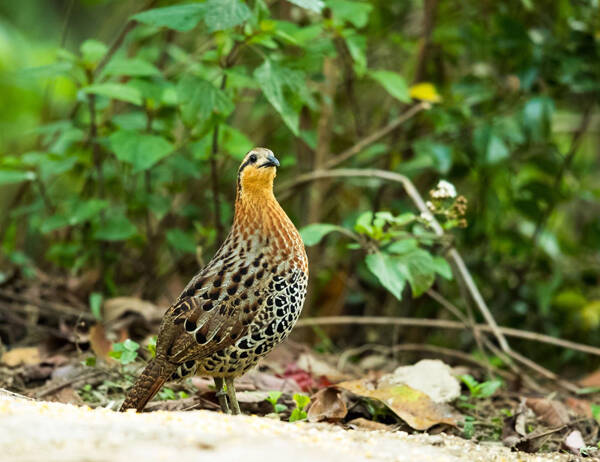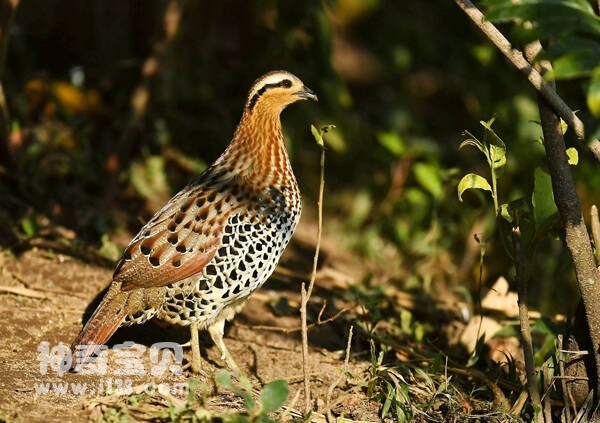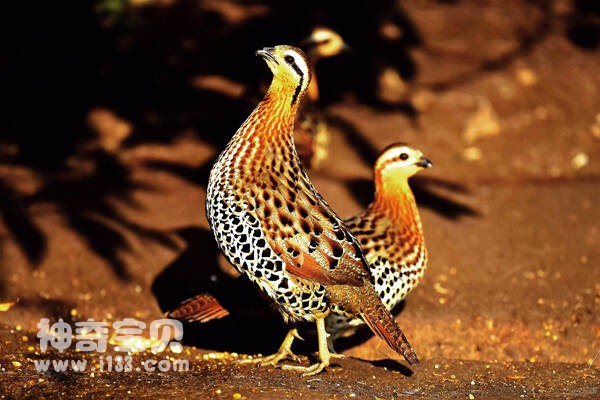Bambusicola fytchii
IUCN
LCBasic Information
Scientific classification
- name:Bambusicola fytchii
- Scientific Name:Bambusicola fytchii,Mountain Bamboo-partridge
- Outline:Landfowl
- Family:Gallinariformes P.family Bambusa
Vital signs
- length:30.3-35.6cm
- Weight:256-360g
- lifetime:No textual research information is available
Feature
Chin, throat and side of the neck tea yellow, chestnut-brown, two sides and abdomen with thick black spots
Distribution and Habitat
It is found in Bangladesh, China (southwestern Sichuan, southwestern Guizhou, western and southern Yunnan), Lao People's Democratic Republic, Myanmar, Thailand, northern Vietnam, Myanmar, and Assam, India.
It lives in the hillside forests, shrubland, tussock and bamboo forests below 3000 meters above sea level, especially in the shrubland and tussock areas near steep mountain gullies and streams. They sometimes forage in wheat fields and roost in trees or bamboo forests at night.
The named subspecies is an uncommon resident bird in Yunnan and southern Sichuan, China, living in tall grasses and bamboo thicket, from low mountains to about 2000 m above sea level.
Appearance
The male bird is brown from the forehead to the pillow, with small but not very obvious black plumage. The eyes are pale brown at first, and a thick black stripe behind the eyes extends backward to the neck; It is followed by a white brown brow line, which also extends back to the neck. Posterior neck chestnut brown, grey-brown feather margin; The upper back, shoulders, secondary coverts and tertiary flight feathers are brown-gray, with dark brown wormlike spots and brown-black proximal central spots, with chestnut brown stripes on both sides; The third class has narrow white end spots, and the lower back, waist and tail are covered with brown feathers, densely covered with small dark brown worm-like stripes. The end of the upper tail cover has white spots, and the center of the end of the longer tail cover has black spots. The tail feathers, primary cover feathers, primary and secondary flight feathers are mostly reddish brown, and the central tail feathers are lighter reddish-brown,
Details
Mountain Bambusicola fytchii is a small chicken similar in size to Mountain Bambusicola Fytchii.

Bamboo chickens usually live in small groups, consisting of a few to more than 20 individuals, with large groups in winter and scattered activities during the breeding season. Each group has a fixed activity area, the feeding ground and habitat are fixed, and the territory is strong. It usually starts at first light and lasts until dusk. They live in bamboo forests or trees at night, often in groups with their heads facing the same direction. When the weather is cold, the individuals are close to each other and often live on the same branch. When the weather is hot, the distance between the individuals is larger, or they live on several branches separately. Most of the time in the grass on the ground, often walk through the grass, and make a 'Sha,Sha' sound. When frightened, they hide in the grass and do not move, generally rarely take off, when people are approaching, they suddenly fly, the group is scattered and flies to all sides, flying quickly, the wings flap faster, but not high, usually flying close to the ground, and not lasting, flying far and falling into the grass. Sometimes they fly up trees, especially when chased by hounds. There is a seasonal vertical migration of short distances, often up the mountainside or mountaintop in summer and down to the piedmont plain in winter. The male birds are unusually noisy in spring, and often fly to the alder perch to sing. How near the stream. When frightened, he flies a few meters and escapes into tall grass.

Bamboo chickens are omnivorous animals. Mainly to plant buds, berries, seeds, soybeans, wheat and other crops for food, but also eat a variety of insects, worms, snails and other animal food.

The breeding period is from April to July. They usually nest in the middle and low mountains and hilly areas between 500 and 2500 meters above sea level. The nest is mostly placed on the ground in grassland or bamboo forest, and occasionally nests on the ground in forests and shrubland. Nests are very simple, mostly hidden pits in the ground, or dug by the birds themselves, and then padded with dead grass and leaves. Each clutch lays 3-7 eggs, usually 4-5 eggs, the shell is thick and hard, the size of the eggs is 36-41 mm ×27-31 mm, an average of 39 mm ×29 mm. Incubation begins after the eggs are laid, and the incubation period is 17-18 days. The chicks are early in life and become mobile soon after hatching and can fly a few days later.
Listed on the International Union for Conservation of Nature (IUCN) 2016 Red List of Threatened Species ver 3.1 - Not Threatened (LC).
It was included in the List of Beneficial Terrestrial Wildlife under State Protection or of Important economic and scientific research Value issued by the State Forestry Administration of China on August 1, 2000.
Protect wild animals and eliminate wild meat.
Maintaining ecological balance is everyone's responsibility!








